Two years ago, the Heritage Foundation Backgrounder “Equity Elementary”REF first examined the extent to which the idea that educational institutions should have Chief Diversity Officers (CDO) had spread from higher education into public school districts. At that time, Heritage reported that 39 percent of all school districts with at least 15,000 students had at least one person serving as a CDO (or with a roughly similar job title). That Backgrounder also examined whether there was a relationship between the presence of a CDO within a district and the size and trend in achievement gaps between minority and white students. Despite CDOs ostensibly having the goal of reducing the extent to which black and Hispanic achievement, on average, lags behind average white achievement, the authors found that districts with CDOs had larger racial achievement gaps, which had been growing larger despite the adoption of CDOs during the preceding decade.
This Backgrounder updates information on the number of school districts with CDOs and conducts a new analysis on how minority student achievement fared during the COVID-19 pandemic in districts with CDOs relative to districts without CDOs.
As of August 2023, 48 percent of school districts with enrollment of at least 15,000 students had a Chief Diversity Officer, up from the 2021 figure of 39 percent. Districts with a CDO were associated with much greater learning loss during the pandemic by black and Hispanic students. Not only did black and Hispanic students experience significantly larger declines in math achievement in districts that had CDOs, but those declines, on average, exceeded the rate of decline among white students in those same districts. This suggests not merely that CDOs utterly failed to arrest the decline, but actually contributed to minority-student learning loss during the pandemic and exacerbated the magnitude of racial achievement gaps.
While CDOs were clearly not focused on reducing learning loss among minority students, their energies appear to have been more strongly directed toward politically contentious issues in school districts that were only tangentially related to learning—if at all. School districts with CDOs were significantly more likely to have adopted policies to keep parents in the dark if their children were experiencing “gender” confusion or dysphoria, including not sharing information about changes in student names, preferred pronouns, and the use of bathrooms. This evidence is consistent with the view that Chief Diversity Officers primarily serve to articulate and enforce ideological orthodoxies opposed by majorities of parents rather than to assist with student learning or closing minority achievement gaps.
Data Collection
To identify whether school districts had a Chief Diversity Officer or someone holding a roughly equivalent position, Heritage Foundation researchers reviewed the websites and organizational charts of the 555 school districts with enrollments of at least 15,000 students. This was supplemented by Google searches involving the name of the district and the key words, “diversity,” “equity,” and “inclusion.”
Student achievement data was obtained from the Educational Opportunity Project at Stanford University.REF Information on the change in student achievement on standardized math tests between 2019 and 2022 was available for all students aggregated at the school district level, as well as for white, black, and Hispanic students in most school districts. In some cases, however, the information for a school district was not available and was recorded as missing.REF Data on racial achievement gaps as of 2018 and the trends in those gaps between 2008 and 2018 was available from the same source.REF
The advocacy organization Parents Defending Education maintains a list of school districts that have policies requiring that information about changes in names, pronouns, or bathroom usage by students be withheld from parents and kept confidential.REF That list was matched with the list of the 555 school districts with at least 15,000 students enrolled.
Results
The Spread of CDOs. Of the 555 school districts examined, 265 (or 48 percent), had a Chief Diversity Officer or its equivalent. This figure is higher than the 214 (39 percent) observed two years ago. The increase was produced by newly finding CDOs in 64 districts, while in 13 districts, the CDO position appeared to have been eliminated, resulting in a net increase of 51 districts. (See Chart 1.)
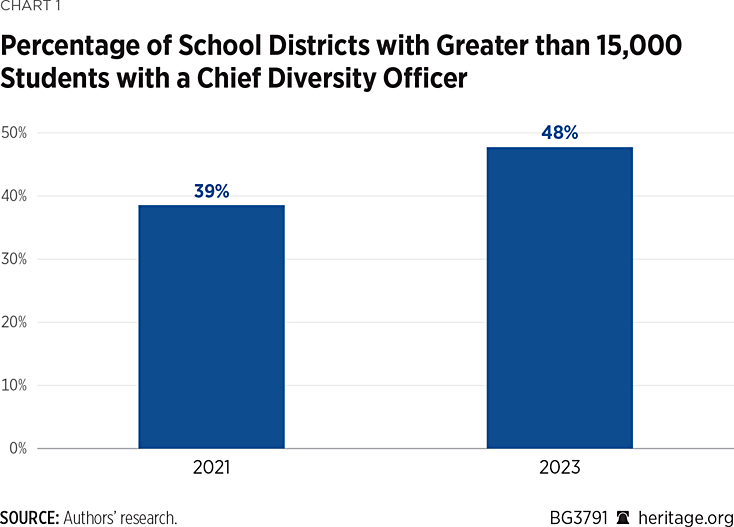
It is possible that some of the increase was produced by finding CDO positions that previously existed but had been missed in the search two years ago. But the bulk of the increase is likely attributable to more school districts creating CDO positions, while only a handful of districts eliminated such positions.
CDOs and Enrollment. Districts with higher student enrollments are more likely to have CDOs. Of districts with more than 100,000 students, 89 percent have CDOs, up from 79 percent two years ago. The biggest increase in the rate of having CDOs occurred among districts with between 50,000 and 99,999 students, of which 77 percent have CDOs, compared to 59 percent two years ago. Of districts with 30,000 to 49,999 students, those with between 20,000 and 29,999 students, and those with between 15,000 and 19,999 students, 41 percent, 44 percent, and 40 percent, respectively, had CDOs. All of these were 8 or 9 percentage point increases higher than what was observed two years ago. (See Chart 2.)
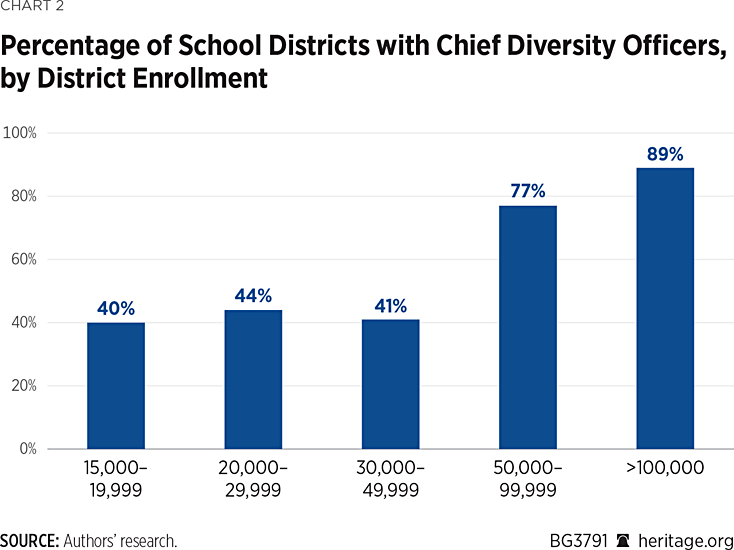
The Relationship Between CDOs and Pandemic Learning Loss by Minority Students. Students of all racial and ethnic backgrounds tended to experience declines in learning during the pandemic. But in districts with CDOs, the learning loss during the pandemic was greater for minority students than it was for minority students in districts that did not have CDOs. In districts with CDOs, black students experienced a decline in math achievement between 2019 and 2022 that was 0.122 standard deviations greater than in districts that did not have CDOs. This difference is statistically significant.
Standard deviations are difficult for laypeople to interpret but are used by researchers to measure changes in achievement outcomes on a common scale when those changes may have originally been recorded using many different units of measurement. To put into perspective the magnitude of an additional loss of 0.122 standard deviations in learning, the average learning loss in math for all students between 2019 and 2022 was 0.494 standard deviations.REF The extra decline in math achievement for black students in districts with CDOs was roughly one-quarter as large as the decline in learning for all students during that period. This extra learning loss translates into roughly 4.5 percentile points on a nationally normed achievement test.REF This is a large effect.
Even if the decline in white achievement in those same districts were statistically controlled, the extra math learning loss among black students in school districts with CDOs was 0.074 of a standard deviation. This is roughly equivalent to an extra learning loss of 2.7 percentile points. Adding controls for the size and trend in black–white achievement gaps prior to the pandemic barely changes the magnitude of the estimated effect of districts having CDOs on the decline in math achievement by black students during the pandemic. (See Table 1.)
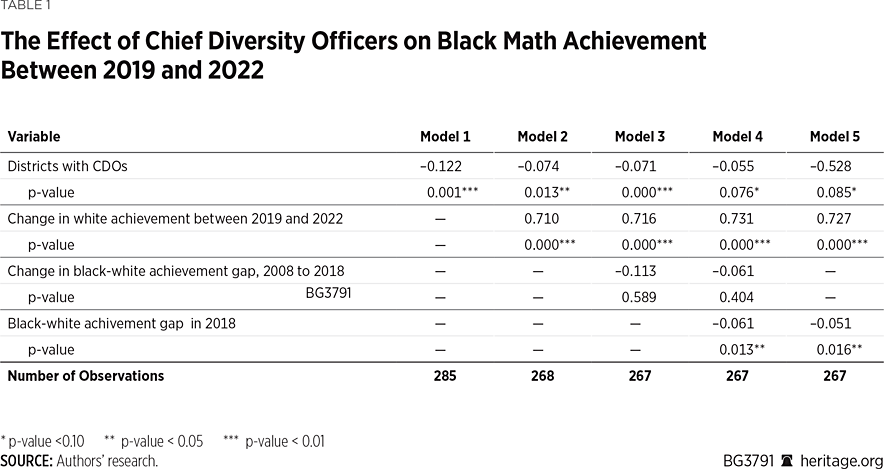
This pattern of results makes it clear that the math achievement of black students fared significantly worse in school districts that had CDOs than in ones that did not. If there were district-specific factors during the pandemic, such as school closures or poor implementation of distance learning that would have affected all students, controlling for the declines in math achievement among white students should account for that. The fact that black math achievement fared significantly worse in districts with CDOs, even after controlling for the change in white achievement, means that CDOs are associated with exacerbated learning loss by black students and widening achievement gaps.
Among Hispanic students, the decline in achievement associated with CDOs was also significantly worse. In districts with CDOs, Hispanic students experienced a decline in math achievement between 2019 and 2022 that was 0.131 standard deviations greater than in districts without CDOs, equivalent to about an extra learning loss of 4.8 percentile points. Adjusting statistically for the change in white achievement in those same districts shrinks the negative effect of CDOs on Hispanic learning loss to 0.087 standard deviations (or about 3.2 percentile points), which is still statistically significant and substantively large. Adding further controls for pre-pandemic racial achievement gaps and trends does not meaningfully alter that negative effect. (See Table 2.)
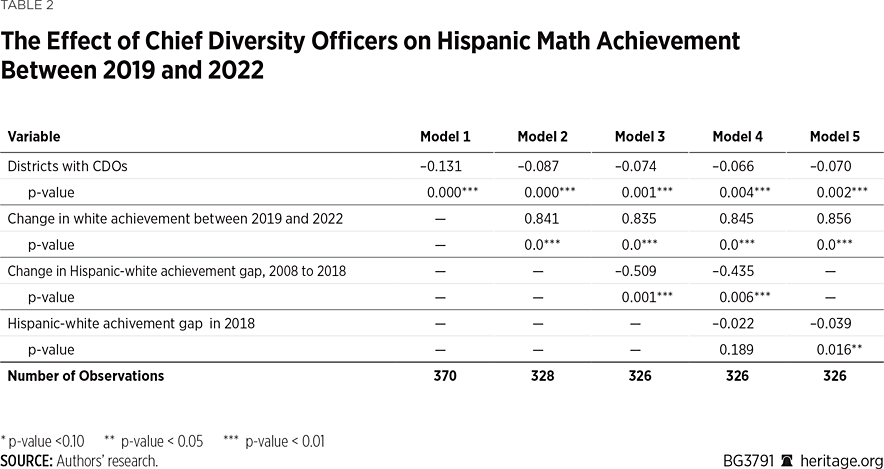
The Relationship Between CDOs and District Policies to Keep “Gender” Secrets. School districts that have CDOs are significantly more likely also to have policies to keep information about changes in students’ self-identified “gender,” names, and pronouns secret from parents. In districts with a CDO, 40.0 percent had policies to keep secrets from parents compared to 17.2 percent of districts without a CDO, a 22.8 percentage points increase in the likelihood of districts having such policies. Even narrowing the comparison to districts within the same states using a linear probability model with fixed effects for each state, a district with a CDO is 15.7 percentage points more likely to have gender-secrets policies than other districts in the same state that do not have CDOs.
Comparing within states is particularly important, because there are statewide policies in some places that otherwise prohibit or require keeping this information confidential. The fact that there are significant differences in the likelihood of having “gender” confidentiality policies depending on whether districts have CDOs within the same state means that the effect is not being driven by CDOs simply being more common in liberal states. (See Table 3.)
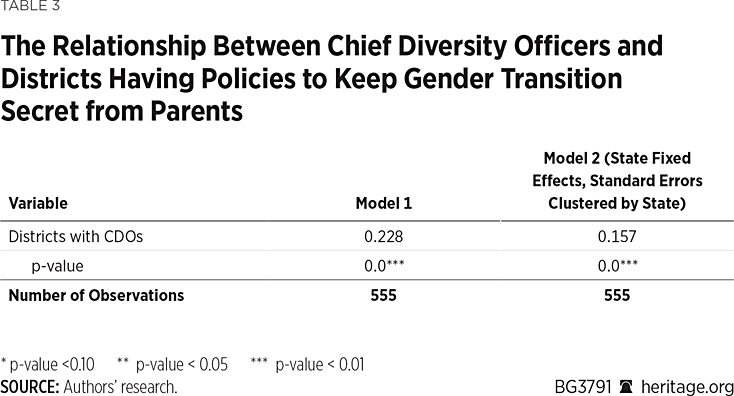
Discussion
An ostensible purpose of having Chief Diversity Officers in K–12 school districts is to address the specific learning needs of minority students and to reduce achievement gaps. The evidence on learning loss during the pandemic makes clear that CDOs are not serving that purpose: CDOs not only failed to stem the magnitude of learning loss by black and Hispanic students during the pandemic, but plausibly worsened achievement gaps.
Rather than devoting their time to ensuring that minority students took equal advantage of all available learning tools and opportunities, it appears that CDOs were focused on pursuing very different agendas. The evidence connecting the presence of CDOs to policies to keep gender secrets from parents suggests that CDOs are more focused on promoting ideological goals than educational ones. If so, then it would come as no surprise that black and Hispanic students in districts with CDOs would experience greater pandemic declines in achievement. CDOs not only failed to stem learning loss among minority students, but the ideology they do emphasize, including a focus on systemic racism and demands to hold minority students to different standards, deprives students of agency and undermines the motivation of both minority students and the staff who serve them.
Given that CDOs are associated with ideological activism and negative effects on student achievement, it is puzzling that more districts are creating such positions. This expansion in the number of CDOs in K–12 schools is even more puzzling since the number of CDOs is beginning to shrink in corporate America.REF We may have reached “peak wokeness” in corporate America, but the peak remains beyond the horizon in K–12 public schools as CDOs continue to spread rapidly. Nearly half of all school districts with at least 15,000 students now have a CDO, significantly up from just two years ago.
It is possible that providing school districts with $190 billion in extra federal funding to address the challenges of the pandemic may have actually exacerbated the situation. Lacking appropriate incentives to use the funds wisely to keep schools open for in-person instruction and address real problems, districts reverted to their default inclination of using extra funds to fuel ideological agendas, including hiring more CDOs.
There are glimmers of hope, however, that the educationally harmful spread of CDOs could begin to reverse.
- The extra COVID-19 funding from the federal government must be spent by the end of 2024. As districts approach that funding cliff, they may begin to look for ways to reduce spending, and eliminating CDO positions may be obvious expenses to cut. Of course, school districts will seek relief from the need to cut spending once COVID-19 funds run out by trying to convince federal, state, and local taxpayers to turn the funding cliff into a plateau with new expenditures. Given the magnitude of the funding cliff and the other pressing demands on taxpayers, it is unlikely districts can avoid making cuts, and CDOs may find themselves on the chopping block.
- Educational institutions have faced a popular backlash against pursuing radical ideological agendas, which has been successful at rolling back some of those excesses. State and local policymakers have managed to adopt policies regarding critical race theory and gender ideology that have curtailed those activities in school districts. If voters and policymakers turn their attention to the dangers posed by CDOs in school districts, they may be successful in reining those in as well. There has already been some success in rolling back diversity, equity, and inclusion bureaucracies in higher education, especially in Florida and Texas, so similar action could be taken in the K–12 arena.
Policy Recommendations
In order to increase the transparency of the role of CDOs—and to prevent the hiring of more CDOs who champion divisive politics in public schools—three groups can and should take action:
- State legislatures should oversee the process by which CDOs are hired and evaluated. If CDOs are deemed unnecessary, or their efforts unproductive or counterproductive, legislative action is wholly appropriate.
- School districts should investigate whether hiring CDOs is associated with improved academic outcomes. If they find, as this Backgrounder does, that CDOs are educationally counter-productive, they should discontinue them.
- Parents should communicate with their local school boards and indicate whether they believe CDO positions should be eliminated. School boards oversee the hiring of taxpayer-funded school employees and have an interest in curtailing ideological activism.
Jay P. Greene, PhD, is a Senior Research Fellow and Madison Marino is a Research Associate and Project Coordinator in the Center for Education Policy at The Heritage Foundation. Kathrine Bedard is a summer 2023 member of the Young Leaders Program at The Heritage Foundation.




